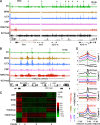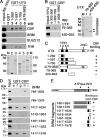Histone demethylase UTX and chromatin remodeler BRM bind directly to CBP and modulate acetylation of histone H3 lysine 27
- PMID: 22493065
- PMCID: PMC3372260
- DOI: 10.1128/MCB.06392-11
Histone demethylase UTX and chromatin remodeler BRM bind directly to CBP and modulate acetylation of histone H3 lysine 27
Abstract
Trithorax group (TrxG) proteins antagonize Polycomb silencing and are required for maintenance of transcriptionally active states. We previously showed that the Drosophila melanogaster acetyltransferase CREB-binding protein (CBP) acetylates histone H3 lysine 27 (H3K27ac), thereby directly blocking its trimethylation (H3K27me3) by Polycomb repressive complex 2 (PRC2) in Polycomb target genes. Here, we show that H3K27ac levels also depend on other TrxG proteins, including the histone H3K27-specific demethylase UTX and the chromatin-remodeling ATPase Brahma (BRM). We show that UTX and BRM are physically associated with CBP in vivo and that UTX, BRM, and CBP colocalize genome-wide on Polycomb response elements (PREs) and on many active Polycomb target genes marked by H3K27ac. UTX and BRM bind directly to conserved zinc fingers of CBP, suggesting that their individual activities are functionally coupled in vivo. The bromodomain-containing C terminus of BRM binds to the CBP PHD finger, enhances PHD binding to histone H3, and enhances in vitro acetylation of H3K27 by recombinant CBP. brm mutations and knockdown of UTX by RNA interference (RNAi) reduce H3K27ac levels and increase H3K27me3 levels. We propose that direct binding of UTX and BRM to CBP and their modulation of H3K27ac play an important role in antagonizing Polycomb silencing.
Figures







Similar articles
-
CBP-mediated acetylation of histone H3 lysine 27 antagonizes Drosophila Polycomb silencing.Development. 2009 Sep;136(18):3131-41. doi: 10.1242/dev.037127. Development. 2009. PMID: 19700617 Free PMC article.
-
Polycomb inhibits histone acetylation by CBP by binding directly to its catalytic domain.Proc Natl Acad Sci U S A. 2016 Feb 9;113(6):E744-53. doi: 10.1073/pnas.1515465113. Epub 2016 Jan 22. Proc Natl Acad Sci U S A. 2016. PMID: 26802126 Free PMC article.
-
Trithorax monomethylates histone H3K4 and interacts directly with CBP to promote H3K27 acetylation and antagonize Polycomb silencing.Development. 2014 Mar;141(5):1129-39. doi: 10.1242/dev.102392. Development. 2014. PMID: 24550119 Free PMC article.
-
Inner workings and regulatory inputs that control Polycomb repressive complex 2.Chromosoma. 2012 Jun;121(3):221-34. doi: 10.1007/s00412-012-0361-1. Epub 2012 Feb 19. Chromosoma. 2012. PMID: 22349693 Free PMC article. Review.
-
Genomic occupancy of the transcriptional co-activators p300 and CBP.Transcription. 2013 Jan-Feb;4(1):18-23. doi: 10.4161/trns.22601. Epub 2012 Nov 6. Transcription. 2013. PMID: 23131664 Free PMC article. Review.
Cited by
-
Molecular Basis of the Function of Transcriptional Enhancers.Cells. 2020 Jul 5;9(7):1620. doi: 10.3390/cells9071620. Cells. 2020. PMID: 32635644 Free PMC article. Review.
-
Roles and epigenetic regulation of epithelial-mesenchymal transition and its transcription factors in cancer initiation and progression.Cell Mol Life Sci. 2016 Dec;73(24):4643-4660. doi: 10.1007/s00018-016-2313-z. Epub 2016 Jul 26. Cell Mol Life Sci. 2016. PMID: 27460000 Free PMC article. Review.
-
Context-Dependent Functions of KDM6 Lysine Demethylases in Physiology and Disease.Adv Exp Med Biol. 2023;1433:139-165. doi: 10.1007/978-3-031-38176-8_7. Adv Exp Med Biol. 2023. PMID: 37751139
-
UTX inhibits EMT-induced breast CSC properties by epigenetic repression of EMT genes in cooperation with LSD1 and HDAC1.EMBO Rep. 2015 Oct;16(10):1288-98. doi: 10.15252/embr.201540244. Epub 2015 Aug 24. EMBO Rep. 2015. PMID: 26303947 Free PMC article.
-
DNA-sequence-specific erasers of epigenetic memory.Nat Genet. 2016 May 27;48(6):591-2. doi: 10.1038/ng.3579. Nat Genet. 2016. PMID: 27230685
References
-
- Agalioti T, et al. 2000. Ordered recruitment of chromatin modifying and general transcription factors to the IFN-beta promoter. Cell 103: 667– 678 - PubMed
-
- Agger K, et al. 2007. UTX and JMJD3 are histone H3K27 demethylases involved in HOX gene regulation and development. Nature 449: 731– 734 - PubMed
-
- An W, Roeder RG. 2003. Direct association of p300 with unmodified H3 and H4 N termini modulates p300-dependent acetylation and transcription of nucleosomal templates. J. Biol. Chem. 278: 1504– 1510 - PubMed
-
- Bannister A, Kouzarides T. 1996. The CBP co-activator is a histone acetyltransferase. Nature 384: 641– 643 - PubMed
Publication types
MeSH terms
Substances
Grants and funding
- R01 GM039255/GM/NIGMS NIH HHS/United States
- S10 RR021228/RR/NCRR NIH HHS/United States
- S10 RR024536/RR/NCRR NIH HHS/United States
- R01HD056369/HD/NICHD NIH HHS/United States
- R01GM084947/GM/NIGMS NIH HHS/United States
- R01 HD056369/HD/NICHD NIH HHS/United States
- RR-021228-01/RR/NCRR NIH HHS/United States
- R01HG004722/HG/NHGRI NIH HHS/United States
- RR-024536-01/RR/NCRR NIH HHS/United States
- RR-017980-01/RR/NCRR NIH HHS/United States
- S10 RR017980/RR/NCRR NIH HHS/United States
- R01 HG004722/HG/NHGRI NIH HHS/United States
- R01GM39255/GM/NIGMS NIH HHS/United States
- R01 GM084947/GM/NIGMS NIH HHS/United States
LinkOut - more resources
Full Text Sources
Molecular Biology Databases
Research Materials
